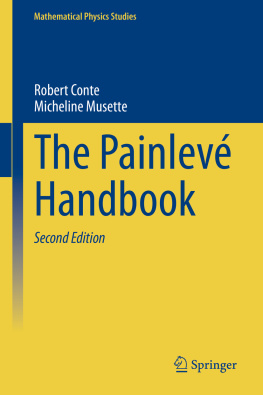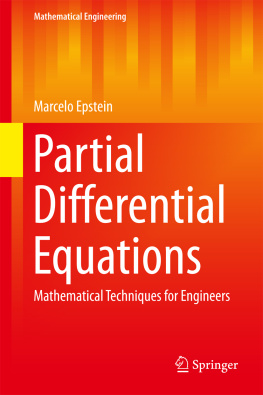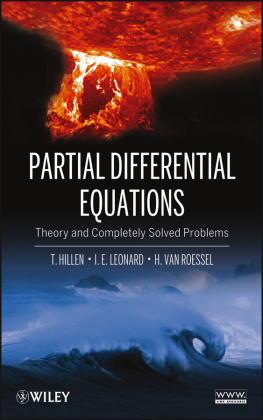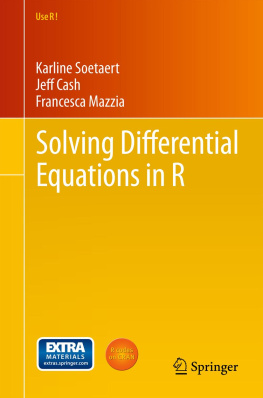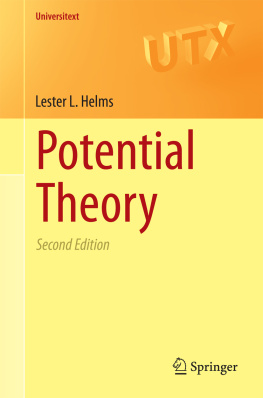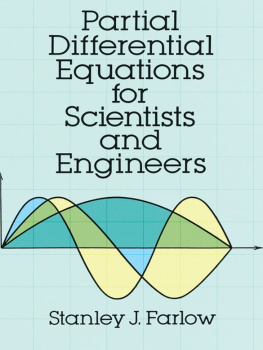The Shape of the Book
This is a book on the history of mathematics; its basic dynamic is historical and therefore, up to a point, chronological. It follows the progress of a number of ideas that grew, sometimes came together, and often developed rich and fascinating branches and applications. At its core is an account of how the calculus of Newton and Leibnizthe calculus of functions of a single variableled to attempts to develop a calculus of functions of several variable and how these new mathematical methods contributed to the study, first of ordinary, and then of partial differential equations. In each case, the rationale for that work was chiefly to develop general methods that could tackle problems in geometry and mechanics (the motions of solids and liquids under the action of forces).
The physical world being a complicated place, most of the applications involved partial differential equations, and here the story soon also became complicated. The first-order partial differential equation in two independent variables was initially difficult to solve, and this posed problems for the study of more than two independent variables and for equations of higher order. Important work on the first-order case was done by Lagrange and Monge before Cauchy was finally able to show that such equations almost always have a solution. But the second-order case almost immediately confined itself to three special cases, somewhat as Euler had suggested, and all of them, as we would say, linear. The first, and simplest, is the wave equation (the prototype hyperbolic equation), successfully tackled by dAlembert. Euler regarded the one later known as the elliptic case (the key example being the Laplace equation) as being beyond current methods. Finally, the case we call parabolic fell through a gap in his approach, and strangely little was said about it before Fourier dealt with the canonical example: the heat equation. At this point, a significant departure from the theory of ordinary differential equations opened up: the need to pay attention to initial or boundary conditions. However, this issue was to remain obscure for several decades.
Euler quickly showed that linear ordinary differential equations with constant coefficients can be solved systematically. Other types of ordinary differential equations were studied in the eighteenth century, but the story is piecemeal, and instead, I chose to give just one example of the history of ordinary differential equations: the hypergeometric equation from Gauss to Riemann, Schwarz, and Poincar. This is one of the glories of the subject, bringing together early ideas about group theory, complex function theory, and the then-novel hyperbolic or non-Euclidean geometry.
So how is all this material organised in this book? Chapter on Riemanns geometric version of complex function theory, which is needed for the subsequent three chapters.
What of the chapters not yet referred to? Chapter are opportunities for revision; when I gave the course I used these lectures to discuss the assessment on the course so far.
The remaining chapters move into what may be less familiar material. Riemanns study of shock waves; Riemann and Weierstrass on minimal surfaces; the work of Thomson and Stokes on the telegraphists equation and the laying of the trans-Atlantic cable; a look at the first ninieteenth-century attempts to rigorise the calculus of variations; the eventual introduction of the fundamental trichotomy (elliptic, parabolic, hyperbolic) for second-order linear partial differential equations and the first general existence theorems in the elliptic and hyperbolic cases including Hadamards insistence of the distinction between initial and boundary value problems. Two chapters look at how Jacobi used Hamiltons ideas to create Hamilton-Jacobi theory and subsequent attempts to geometrise mechanics, and the connection to the solution of first-order partial differential equations.
All this material has a certain coherence that is worth spelling out. Ordinary differential equations grew out of, or alongside, problems in evaluating integrals, which is why we still talk, confusingly, of integrating a differential equation and its solutions as its integrals. It was soon recognised that the solution to an ordinary differential equation was a family of functions and an individual solution could be specified by means of some initial conditions. So, it was natural when differential equations with several independent variables were investigated that the earliest researchers (Jean le Rond dAlembert, Leonhard Euler, Pierre Simon Laplace, and Joseph-Louis Lagrange) thought of these partial differential equations in the same way, and looked for techniques that would produce a formula for the general solution (however, they seldom also discussed an auxiliary process of fitting the general solution to some initial conditions). Part of the story here is the gradual recognition that this is not the right way to think of partial differential equations. Rather, it is a dialogue between the general methods and the initial or boundary conditions that is central, and which underpins the crucial distinction between the elliptic and hyperbolic types to which formal methods are blind. As we shall see, this explains the problematic way in which complex variables were first used.


